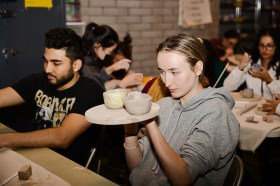There are literally hundreds of art prizes in the UK. Surely that would suggest there are at least a number of them that are the right fit for you to enter? ArtsHub has pulled together a few tips on how to identify your options, and put your best work forward.
Jump to:
1. Do your homework
Call it legwork, call it research – either way, you will have a better chance if you have your head around the criteria of the prize you are entering. And we are not just talking about a read through the application form. If you are serious, dig a little deeper and look at which artists have won in past years, what works have been selected for the finalist exhibition and if it is a prize run by a local council or an institution. Then take a look at their mission statement and their other programming.
You want to submit to your strengths, so find the prize that is best aligned to your studio practice. On one level that is simple – it may be led by genre or style. “I’m a traditional landscape painter.” “I take raw and real photos of people.” “Sustainability is at the heart of what I make.”
Don’t stretch the interpretation of what you do to fit a prize. For example, if you are a landscape painter don’t just add a figure and stick it in a portrait prize. Or perhaps you paint, what you think is a killer painting, so you enter it in everything. The judges will look at your oeuvre and it will come across as disingenuous.
And, obviously, stick to the brief. Make sure you are submitting an artwork that fits the size, medium and thematic restrictions.
2. Get them feeling
Art prizes generally attract a much broader gallery-going, or non-gallery, audience. This doesn’t mean you need to compromise what you do, but again chose appropriately which is the right the prize for you.
Artworks that trigger emotions are always winners with the public. While this may not be a tick box on the judge’s list of criteria, it may put you in good running for a People’s Choice Award – which can often also be a handsome pot of winnings, and a good CV gong.
And, if you are painting a landscape or a portrait, then always use your own reference photos and not some you have randomly plucked – that’s just wrong on so many levels.
3. Edit yourself
One of the hardest things for any artist to do is to edit their work – that is, to honestly recognise which are the good pieces, and those that teeter towards failures. It is a little like naming your favourite child – forbidden and too heartfelt to separate. But, if you expect a prize judge to look at your work with a critical eye, then that has to start with you first.
It will also demonstrate to the judges that you have a solid understanding of your practice, and also a good grasp of the prize’s expectations.
Remember, you are not selecting a good painting; you are selecting a good prize entry. It goes without saying it has to be a resolved artwork. And when you think you have the right piece – pull up those criteria and past finalists and ask yourself: “Do I fit?”
In an earlier conversation with ArtsHub, curator and frequent art prize judge Sebastian Goldspink said that one of the main things he looks for is a demonstration that, ‘An artist is reaching for something, extending themselves and their practice. Work that is well finished, as opposed to polished – it has to have an intention and a dynamism. It can be grungy or provisional, but without intent it falls flat. Work that feels sympathetic to the other works in the final, but stands out.’
Read: Lessons from an art prize judge
4. A good image is everything
Now that you have chosen what you are submitting and where, you need to focus on how you present it in your application.
The first round of selection, for pretty much most prizes these days, is done on screen – that is either independently on a personal computer or projected to a group of selectors.
A bad image will eliminate you immediately. It needs to be of a high enough quality that they can zoom in. It needs to be lit well, so that the colour feels accurate. And you want the image to be presented clean, so crop out all surrounding information.
5. Cut the art speak
Next is your statement. In most cases, artists are asked to supply a short statement about the work. The number one piece of advice is – cut that art speak. No one likes an art w***er.
Statements are all about connecting people from all works of life to the image that is in front of them. Keep it honest, personable and you – approach it as if you are there with a cuppa, and have a genuine chat about why this subject fascinated you, and why you were compelled to make it to share with others.
Read: The problem with art prize communication
6. Temper your expectations
Yep … you probably won’t win. Even if you are super confident – you probably won’t win. We think that digital browsing has crazy algorithms? Well, art prize judging can also fall into its own odd pattern of selection.
The one thing you can be guaranteed of by entering though is exposure. The judges need to familiarise themselves with your work. A whole new audience will be exposed to your art-making. Often gallerists are sniffing around prizes for fresh talent. And – best of all – it is a great professional development experience for you.
Painting to a prize brief is also good practice for commissions or public artworks that require conditions and criteria to be met, while also creating something original and engaging to a broad audience.





